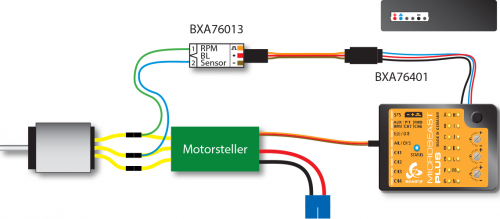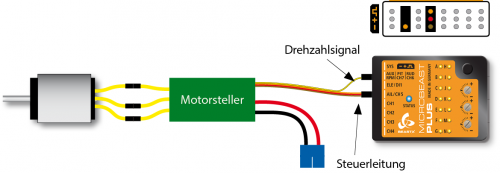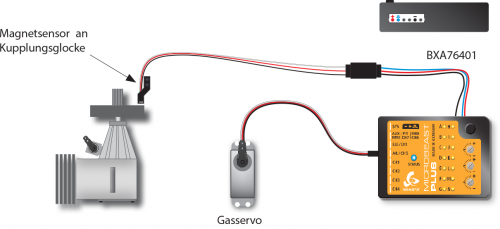Manuals:MB Plus:Governormenu A/de: Difference between revisions
Shornstein (talk | contribs) Created page with "===Elektroantrieb - Motorsteller mit Ausgang für das Drehzahlsignal=== Wenn ein Motorsteller mit separater Signalleitung für das Drehzahlsignal verwendet wird, so kann diese..." |
Shornstein (talk | contribs) Created page with "===Antrieb mit Verbrennungsmotor=== Achten Sie insbesondere bei Sensoren für Verbrennungsmotoren auf polrichtigen Anschluss des Sensors am Adapterkabel BXA76401. Hier werden..." |
||
| Line 25: | Line 25: | ||
<br /> | <br /> | ||
=== | ===Antrieb mit Verbrennungsmotor=== | ||
Achten Sie insbesondere bei Sensoren für Verbrennungsmotoren auf polrichtigen Anschluss des Sensors am Adapterkabel BXA76401. Hier werden üblicherweise Sensoren verwendet, die für externe Drehzahlregelsysteme anderer Hersteller konzipiert wurden und daher eine spezielle Pinbelegung aufweisen und bei denen die Farben der Anschlusskabel nicht der Norm entsprechen (beim Align Governor Sensor HE50H22 sind beispielsweise die Kabelfarben vertauscht. Hier kennzeichnet rot den Minuspol und schwarz den Pluspol!).<br /> | |||
<br /> | <br /> | ||
[[Image: | [[Image:Governormenu_A_nitro_de.png|500px|none]]<br /> | ||
<br /> | <br /> | ||
Revision as of 11:37, 10 June 2015
Damit der Drehzahlregler von MICROBEAST PLUS verwendet werden kann, muss das System die Motordrehzahl erfassen können. Dies erfolgt mit einem Drehzahlsensor, der an den Sensoreingang von MICROBEAST PLUS angesteckt werden muss. Bei Modellen mit Verbrennungsmotor werden üblicherweise Sensoren verwendet, die das Drehzahlsignal magnetisch oder optisch ermitteln. Diese Sensoren werden an Kurbelwelle oder Kupplungsglocke montiert und registrieren hier die Anzahl der Motorumdrehungen. Bei Elektromotoren kann die Motordrehzahl elektronisch anhand der Felddrehzahl des Motors ermittelt werden. Hierzu wird ein Phasensensor (z.B. BXA76013) an eine oder zwei der Motorphasen angeschlossen. Einige Motorsteller besitzen auch direkt einen Anschluss für das Drehzahlsignal, so dass kein zusätzlicher Sensor notwendig ist.
Wie der Sensor zu montieren ist entnehmen Sie bitte der Anleitung vom Sensor bzw. vom Helikopter. Das Kabel mit dem Drehzahlsignal wird mit dem optional erhältlichen Sensor Adapterkabel BXA76401 am Sensoranschluss der seitlichen Steckerleiste von MICROBEAST PLUS angeschlossen. Über diese Steckerleiste wird der Sensor auch mit Spannung versorgt, falls notwendig. Beachten Sie, dass die Höhe der ausgegebenen Spannung der Versorgungsspannung von MICROBEAST PLUS entspricht!
Nachfolgend einige Montage- und Anschlussbeispiele. Wie beschrieben können nahezu alle Arten von Drehzahlsensoren verwendet werden. Leider ist es unmöglich sämtliche Typen auszuprobieren und aufzuzählen. Wenden Sie sich im Zweifel an Ihren Fachhändler um zu erfahren, ob ein bestimmter Sensor in Verbindung mit MICROBEAST PLUS verwendet werden kann.
Elektroantrieb - Externer Phasensensor
Verbinden Sie die Leitungen des Phasensensors mit zwei beliebigen Phasen des Elektromotors. Es empfiehlt sich die Leitungen an die Steckkontakte des Motorstellers anzulöten. So ist ein späterer Motorausbau z.B. zu Wartungszwecken einfacher. Bei manchen Phasensensoren ist die Verwendung von einer Messleitung ausreichend. Überlicherweise ist das der Fall wenn der Motorsteller das System über eine BEC - Stromversorgung vom Antriebsakku speißt und dadurch keine galvanische Trennung zwischen Motor- und Empfängerstromkreis vorliegt. Wir empfehlen dennoch stets beide Messleitungen anzuschließen. So ist gewährleistet, dass der Sensor ein möglichst störungsfreies Signal liefert.
Der Motorsteller wird am Ausgang [CH5] angesteckt.

Elektroantrieb - Motorsteller mit Ausgang für das Drehzahlsignal
Wenn ein Motorsteller mit separater Signalleitung für das Drehzahlsignal verwendet wird, so kann diese statt an dem seitlichen Sensoranschluss alternativ auch am Anschluss [RPM] an der vorderen Steckerleiste von MICROBEAST PLUS angesteckt werden (unterster Pin des 3-fach Signalanschluss). Drehzahlsensoren können hier aber nicht angeschlossen werden, da an dieser Stiftleiste keine Möglichkeit für die Spannungsversorgung gegeben ist!
Der Motorsteller wird am Ausgang [CH5] angesteckt.

Antrieb mit Verbrennungsmotor
Achten Sie insbesondere bei Sensoren für Verbrennungsmotoren auf polrichtigen Anschluss des Sensors am Adapterkabel BXA76401. Hier werden üblicherweise Sensoren verwendet, die für externe Drehzahlregelsysteme anderer Hersteller konzipiert wurden und daher eine spezielle Pinbelegung aufweisen und bei denen die Farben der Anschlusskabel nicht der Norm entsprechen (beim Align Governor Sensor HE50H22 sind beispielsweise die Kabelfarben vertauscht. Hier kennzeichnet rot den Minuspol und schwarz den Pluspol!).

Sensor function test
At menu point A we check whether the rpm sensor is functioning properly and the rpm sensor wire is connected correctly and in general if there is a usable rpm signal. Watch out! At this menu point the throttle channel is unlocked. This means you have full control over the throttle output [CH5] with your remote control to control the speed controller or throttle servo.
When using an electric model it is necessary to increase the throttle until the motor starts to rotate and the phase sensor or the speed controller outputs a rpm signal. Once the motor is running the Status-LED on the MICROBEAST PLUS should light up in red color.
With a nitro/gas powered helicopter you can simply rotate the clutch or engine crankshaft by hand until the signal generator (magnet or similar) passes the sensor. Whenever the signal generator is within the detection range of the sensor the Status-LED should light up in blue color.
If the Status-LED on the MICROBEAST PLUS does not light up as described please double check the wiring. Particularly pay attention whether the power wires of the sensor are of correct polarity (on some sensors the wire colors do not match the usual standard!). If you have a magnetic sensor check if the magnets are installed with the correct polarity and if they are passing the front of the sensor close enough. Using a crankshaft sensor make sure that the sensor is mounted close enough to the frame accordingly.
In addition to the function control of the sensor, check the throw setting for the throttle servo in the remote control and adjust if necessary: Set the throttle to mid stick position and attach the servo horn, so that the throttle linkage is at a right angle to the servo horn. Then adjust the length of the linkage according to the instructions of the helicopter, so that it also is positioned perpendicular to the linkage lever at the carburetor. Adjust the lever at the carburetor so that it is opened halfways (note the markings on the carburetor!). Now move the throttle stick towards full throttle and adjust the servo travel in the transmitter accordingly, so that the full throttle position is reached without binding. Lastly move both throttle stick and throttle trim on the transmitter to the „motor off“ position and also adjust the servo travel in that direction until the carburetor is fully closed. If the servo travel must be greatly reduced in both directions, it is recommended that the linkage ball on the servo arm is mounted further in so that the servo can be moved over a wider range. For more information, refer to the instruction manual for your helicopter.
Also with an electric model, the control range of throttle is crucial. Usually here the throttle endpoints of the transmitter are fixed by an initial programming of the speed controller. But also speed controller exist that require adjusting the servo throw of throttle channel in the transmitter, so that the throttle range is in accordance with the specification of the speed controller. At menu point A there is the possibility to check again whether this setting has been performed correctly. Carefully apply some gas. The motor should start to turn immediately if you move the stick just a little bit and full speed should be reached when the stick just reaches full throttle position. If the engine turns much earlier at the maximum possible speed or only starts to turn at a very high stick deflection decrease the travel of throttle channel in the transmitter or repeat the programming of the speed controller. Thus the RPM Governor of MICROBEAST PLUS can operate correctly, the motor speed should increase as linear as possible when the stick is moved and there should be no ranges in that the motor speed does not change.
Watch Out! Electric motors rotate at high speeds. Keep a safe distance during the function test. We highly recommend to remove the motor from the main gear. However, please observe the manufacturer‘s specifications of the motor. Some motors may not be operated without load. In this case only let the motor run for a short time or let the motor stay attached to the main gear and only remove the main and tail rotor blades (Warning! Increased risk of injury).
If in doubt, do without the function test or throw adjust of the throttle stick.
When finished briefly push the button to save the configuration and to proceed to Governor setup menu point B.